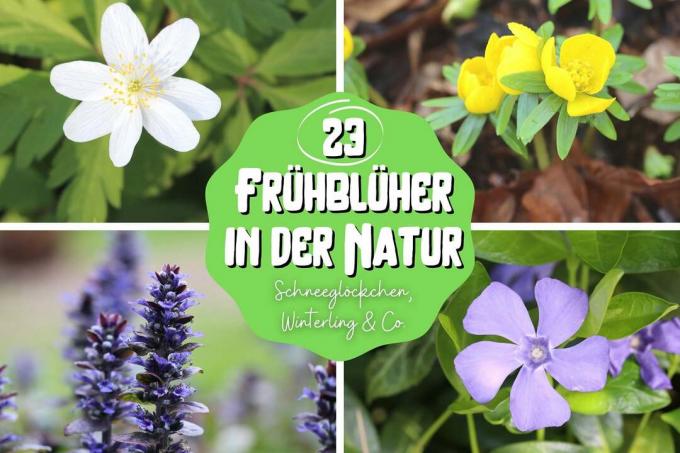
table of contents
- White early bloomers
- Yellow early bloomers
- Green early bloomers
- Blue early bloomers
- Purple early bloomers
- Multicolored early bloomers
- frequently asked Questions
Wildflowers are the first sign of spring when nature has awakened. They offer insects an important source of food and bathe the garden in a blaze of color early in the year.
In a nutshell
- Early bloomers usually need sun in spring and shade later
- are important food sources for insects
- shine in different colors
- some wildflowers, such as snowdrops, retire completely after fruiting
White early bloomers
wild garlic (Allium ursine)

Wild garlic is one of the most popular wild herbs in spring.
- Location: alluvial forests, semi-shade
- Flowering time: April - May
- Flower shape: small, star-shaped individual flowers combined into a umbel
- Height: up to 30 cm
- Propagation: seeds, bulbs
Attention: Ramsons can easily be combined with poisonous plants such as autumn crocus (Colchicum autumnale) or lily of the valley (Convallaria majalis) can be confused. Only collect it if you are really sure.
Hairy bittercress (Cardamine hirsuta)
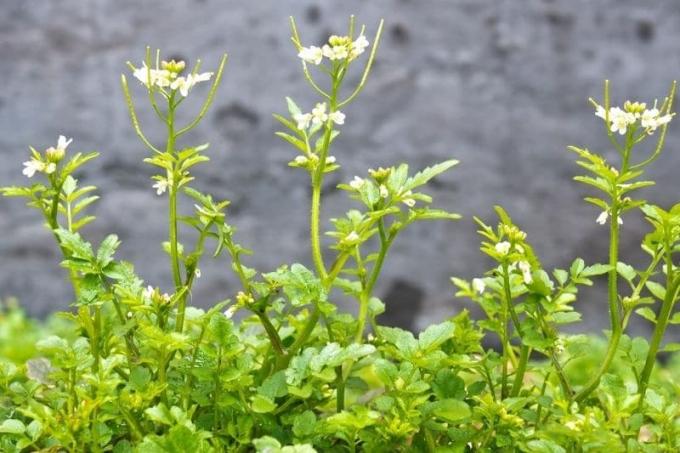
The hairy bittercress is usually perceived as an annoying weed in the garden in spring. In spring, however, it is an important food source for the Aurora moth (Anthocharis cardamines), which specializes in cruciferous vegetables.
- Location: Gardens, fields, ruderal areas
- Flowering period: March - June
- Flower shape: small individual flowers grouped into umbrella-shaped flower clusters
- Height: up to 30 cm
- Propagation: seeds
Wood Anemone (Anemone nemorosa)

The wood anemone is one of the wild flowers that depend on animal help for reproduction. As with violets, the seeds are carried away by ants, which means that they can also form new stocks further away.
- Habitat: Deciduous forests with lots of light in spring
- Flowering period: March - May
- Flower shape: open single flower
- Height: up to 25 cm
- Propagation: seeds, runners
Spring Snowflake (Leucojum vernum)
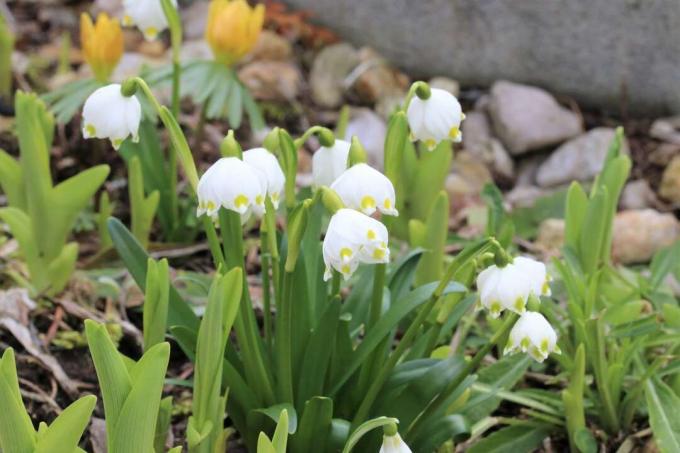
The March cup is an early bloomer that is under protection and can only rarely be found in nature. However, further propagated wild forms are offered in the trade and are suitable as bulb plants for the garden.
- Location: deciduous forests, alluvial forests
- Flowering time: March - April
- Flower shape: bell-shaped
- Height: up to 30 cm
- Propagation: seeds, bulbs
daisy (Bellis perennis)
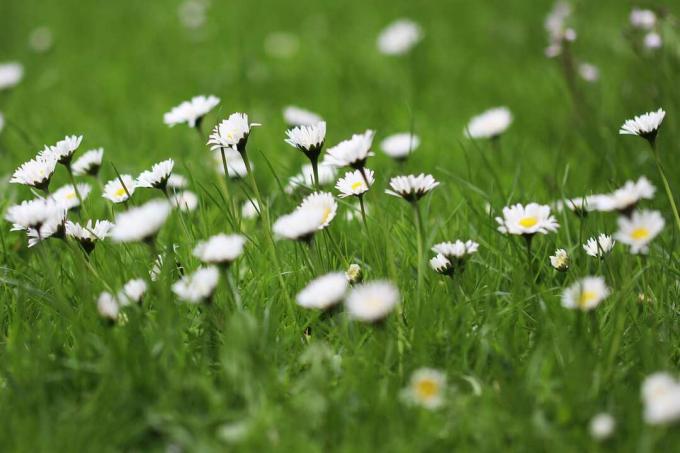
in the race The daisy is one of the first wildflowers in spring. As soon as the vegetation gets taller, the willingness to bloom decreases again.
- Location: nutrient-rich soil, meadows, lawn
- Flowering period: March - November
- Flower shape: small daisy flowers
- Height: up to 15 cm
- Propagation: seeds
Shepherd's purse (Capsella bursa-pastoris)
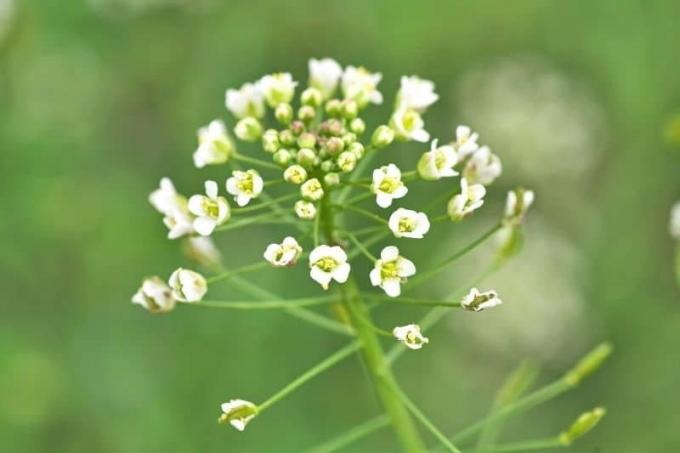
The shepherd's purse used to be seen along fields. Due to the use of herbicides, the population is greatly reduced.
- Location: fields, gardens, ruderal sites
- Flowering period: April - December
- Flower shape: small single flowers, spike-shaped
- Height: up to 50 cm
- Propagation: seeds
Notice: The shepherd's purse is usually annual. Occasionally it can happen that plants overwinter as a rosette.
Garlic mustard (Alliaria petiolata)
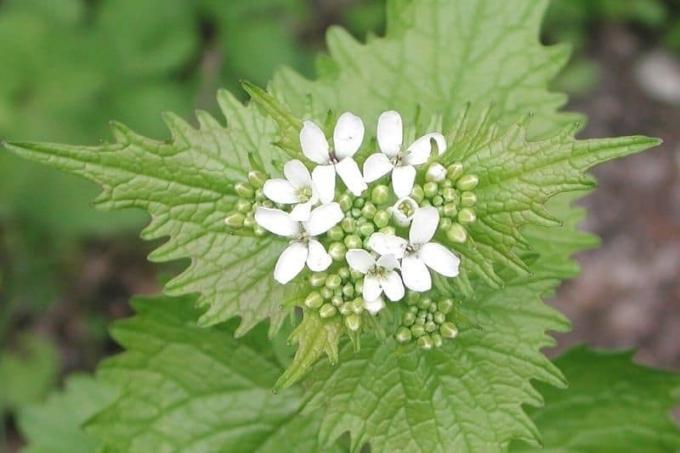
What is striking about garlic mustard is its leek-like smell. The flowers are for many butterflies an important food source.
- Location: fields, gardens, ruderal sites
- Flowering period: April - December
- Flower shape: small single flowers, racemose
- Height: up to 100 cm
- Propagation: seeds
Snowdrop (Galanthus nivalis)
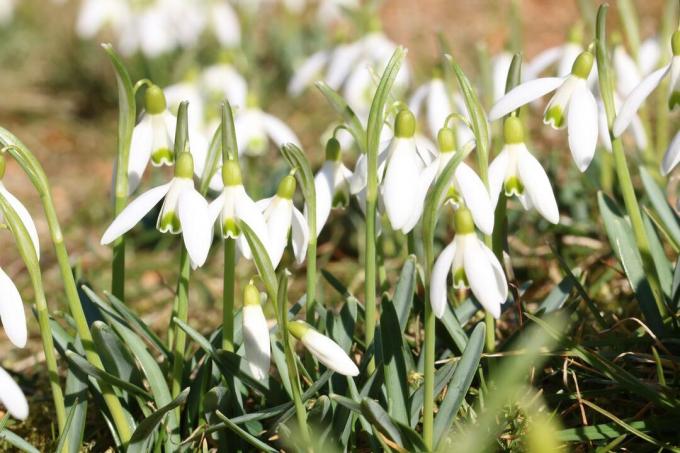
The Lesser Snowdrop is the only native snowdrop species in Central Europe. The wild flowers are protected, but the early bloomers are also commercially available as a cultivated form.
- Location: partially shaded meadows
- Flowering period: February - March
- Flower shape: open bell-shaped
- Height: up to 15 cm
- Propagation: seeds
woodruff (Galium odoratum)

Woodruff is an aromatic wild herb that is one of the later early bloomers. Harvested correctly, it can be used in many ways in the kitchen.
- Location: moist forests, deciduous forests
- Flowering period: April - June
- Flower shape: small individual flowers, grouped into whorls
- Height: up to 50 cm
- Propagation: seeds, runners
Yellow early bloomers
coltsfoot (Tussilago farfara)
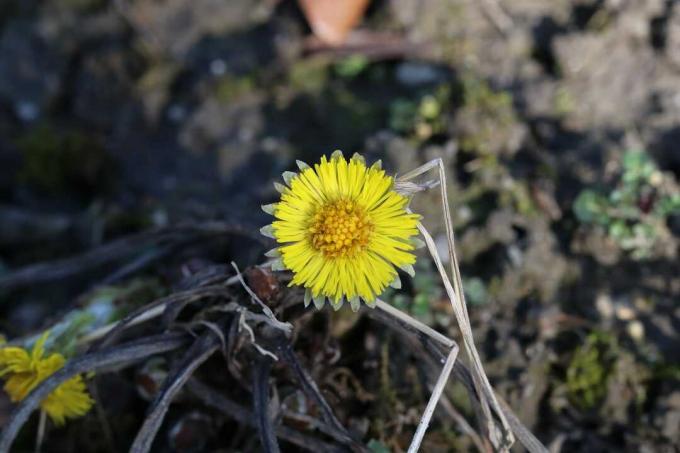
Coltsfoot leaves are often confused with butterbur (petasites). However, older leaves of butterbur are significantly larger than those of coltsfoot.
- Location: Gravel areas, ruderal areas, roadsides
- Flowering time: March - April
- Flower shape: large daisy flowers
- Height: up to 30 cm
- Propagation: seeds, runners
dandelion (Taraxacum officinale)
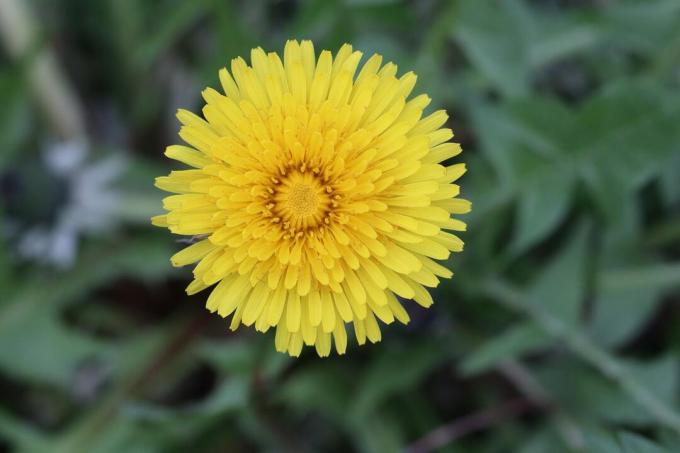
The dandelion is one of the most important Forage plants for insects in the spring. Due to the intensive management of the meadows, its population is steadily declining in favor of grasses.
- Location: fertile meadows, sun to semi-shade
- Flowering time: April - May
- Flower shape: large daisy flowers
- Height: up to 30 cm
- Propagation: seeds
Notice: There are hundreds of different subspecies of dandelion. With the naked eye, however, optical differences in subspecies can usually only be detected sporadically on the leaves.
Cowslip (Primula)

There are several types of cowslips that belong to the early bloomers. The cowslip (Primula elatior) and the cowslip (Primula veris) are particularly widespread.
- Location: humus-rich fresh soil, light deciduous forests, partially shaded meadows
- Flowering period: March - May
- Flower shape: trumpet-shaped clustered together
- Height: up to 30 cm
- Propagation: seeds
Winterling (Eranthis hyemalis)
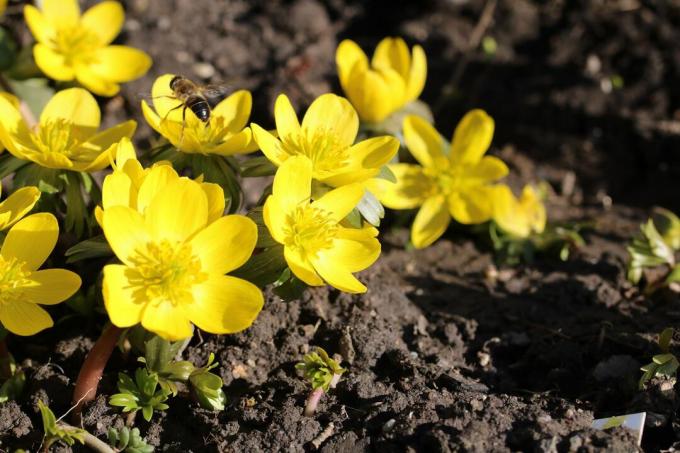
Winterling is one of the first flowering plants in spring. Above all, he offers bumblebee queens, which seek nesting sites in early spring, are a good food source.
- Location: humus-rich fresh soil, light deciduous forests, partially shaded meadows
- Flowering period: March - May
- Flower shape: open single flowers, prominent bracts
- Height: up to 20 cm
- Propagation: seeds
Green early bloomers
Herb Paris (Paris quadrifolia)

The Einberry is usually noticeable when it is in the fruit ripening stage. The black individual fruits at the top of the plant are very conspicuous.
- Location: fertile meadows, sun to semi-shade
- Flowering period: April - June
- Flower shape: prominent large bracts
- Height: up to 30 cm
- Propagation: seeds
Spotted Arum (Arum maculatum)

The spotted arum is rather inconspicuous in the flower. Only in autumn does it attract attention with its distinctive orange-red infructescence.
- Location: fertile meadows, sun to semi-shade
- Flowering time: April - May
- Flower shape: large daisy flowers
- Height: up to 40 cm
- Propagation: seeds
Attention: All plant parts of the aroid are highly toxic. When handling the plant - especially for small children and pets - caution is required.
Stinking Hellebore (Helleborus foetidus)

Hellebore blooms in the winter if temperatures are warm enough.
- Location: calcareous clay soils, oak and beech forests
- Flowering period: February - April
- Flower shape: Cup-shaped flowers gathered in clusters
- Height: up to 90 cm
- Propagation: seeds
Blue early bloomers
Field forget-me-not (Myosotis arvensis)
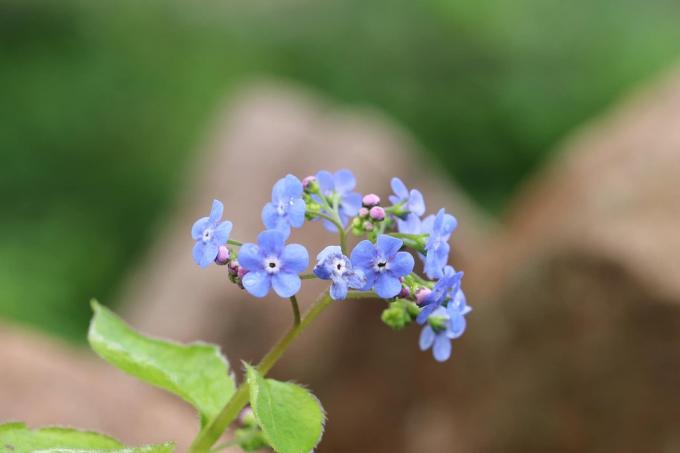
The field forget-me-not is biennial and only flowers in the second year.
- Habitat: Gardens, fields, field edges
- Flowering time: April - May
- Flower shape: Individual flowers grouped into spikes
- Height: up to 40 cm
- Propagation: seeds
bugle (Ajuga reptans)
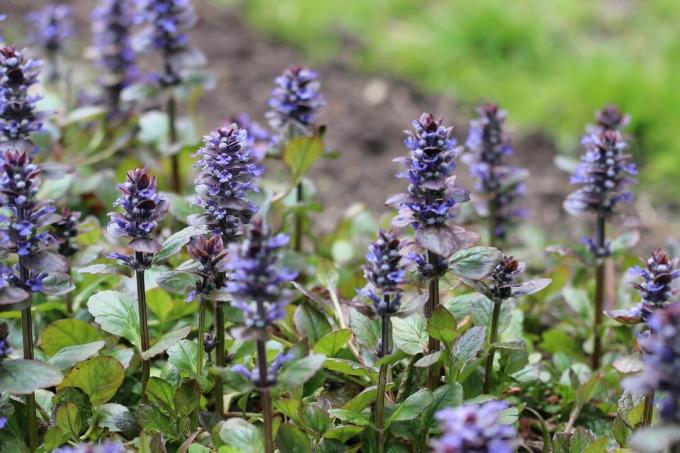
The Günsel usually has red-brown foliage early in the year. This protects it from the sun's rays in spring.
- Location: fresh nutrient-rich soil, deciduous forests
- Flowering time: April - May
- Flower shape: Lip flowers
- Height: up to 30 cm
- Propagation: seeds, runners
Notice: The Günsel is an easy-care ground cover in the garden. In nature, however, it is not very competitive and prefers lower vegetation in the area.
Persian Speedwell (Veronica persica)
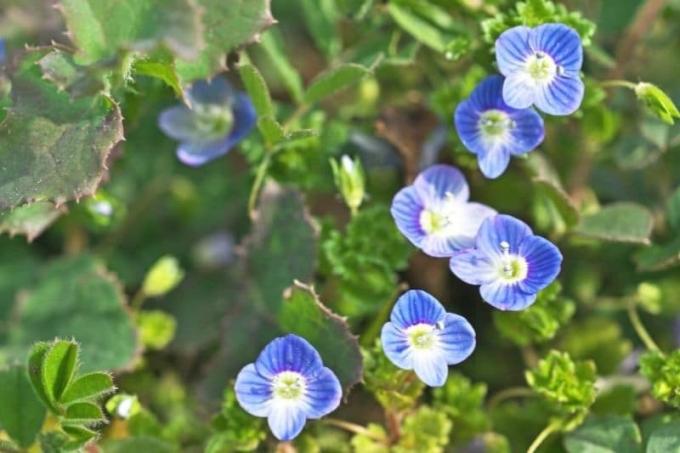
The Persian speedwell originally comes from the Caucasus. Around the 19th In the 19th century it spread across Europe, starting from a botanical garden.
- Location: fields, gardens, man-made landscapes
- Flowering period: February - October
- Flower shape: small single flowers
- Height: up to 40 cm
- Propagation: seeds, runners
Purple early bloomers
Ground ivy (Glechoma hederacea)

This pioneer plant is better than its reputation. Often as weed notorious, their purple flowers set decorative accents in the garden. You can also use ground ivy as a medicinal and kitchen plant, for example in salads and tea.
- Location: slightly moist and calcareous soil, sun to semi-shade
- Flowering period: April - July
- Flower shape: small lip flowers
- Height: up to 30 cm
- Propagation: seeds, runners
Small periwinkle (Vinca minor)

There are several species of periwinkle that are native. All species bloom early in the year, but the lesser periwinkle is the species that blooms most profusely.
- Habitat: humic, nutrient-rich soils, deciduous forests
- Flowering period: March - June
- Flower shape: funnel-shaped single flowers
- Height: up to 15 cm
- Propagation: seeds, runners
Notice: Occasionally it can happen thata plant also flowers in white.
violet (viola)
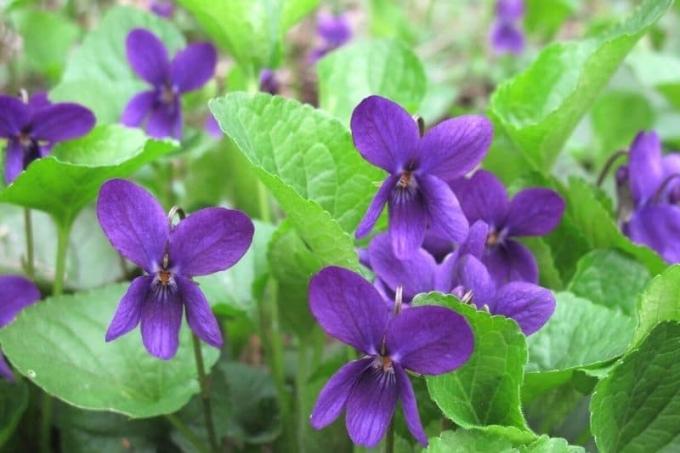
There are several types of violets that are early bloomers. In addition to the fragrant violet (Viola odorata), the dog violet (Viola carina) also blooms early in the year.
- Habitat: humus rich soil, semi-shade, forest clearings, forest edges
- Flowering period: March - May
- Flower shape: medium-sized single flowers
- Height: up to 30 cm
- Propagation: seeds, runners
Multicolored early bloomers
Lungwort (Pulmonaria officinalis)
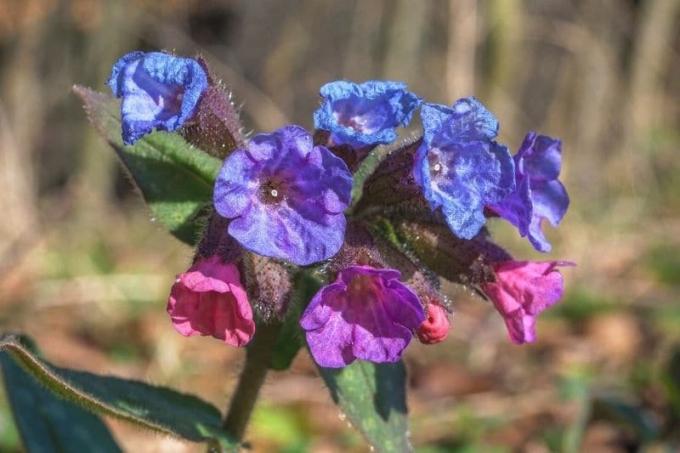
In the case of lungwort, it is not just the multi-colored flowers that appear due to a change in the pH value change color after pollination, but also because of their foliage. The leaves are covered with white spots.
- Location: sparse deciduous and mixed forests, forest edges
- Flowering time: March - April
- Flower shape: tubular flowers
- Height: up to 20 cm
- Propagation: seeds
frequently asked Questions
Yes, especially early bloomers can be settled well in the garden. It is important that they have a suitable location. Early bloomers such as wild garlic or wood anemones usually need a lot of light in spring, later they benefit from fruit trees that provide shade. A meadow that is only mowed two or three times a year also promotes the establishment of wild flowers such as dandelions.
Basically, insects benefit from almost all spring flowers. However, some species specialize in specific plants, such as cruciferous vegetables. These decrease due to the cultivation of the areas, which means that the insects have fewer and fewer food sources. With cruciferous vegetables such as hairy bittercress or garlic mustard you can specifically encourage insects.
Yes, some species such as the wood anemone or the snowdrop are very suitable for perennial beds. Some species have the advantage that they retreat back into the ground after fruiting, making room for other flowering plants.
